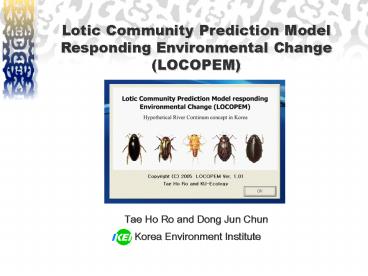Method of RAPD PowerPoint PPT Presentation
1 / 32
Title: Method of RAPD
1
Lotic Community Prediction Model Responding
Environmental Change (LOCOPEM)
Tae Ho Ro and Dong Jun Chun Korea Environment
Institute
2
Why the water ?
? The most critical factor for the survival of
life Our future will be deeply compromised
unless we learn to manage water as a critical
ingredient of our lives. (Myers, 1993) ? The
decline in the distribution, abundance, and
quality of water and aquatic ecosystem represents
a threat to the sustainability of all living
systems and the quality and long-term viability
of human society.
3
Changing perspective on water quality
- Past
- ? Pollution was caused by chemicals
- e.g., sediment was not a pollutant.
- ? Interested in the wastewater treatment,
drinking water, human-centered policy. - ? Not interested in the effects of action.
- ? Society ignored biology.
4
Changing perspective on water quality
Changing ? The survival of human society
depends on the nature, and it tided with the
harmony of nature. ? Biology of water represents
the health of a water body. ? Ecological quality
of water included hydrological, chemical,
physical, and biological integrity. ? To view
water quality standard as a holistic, affirmative
statement of the overall integrity of a water
body.
5
The holistic (integrative) view of a water body
6
What is the health of water body ?
- ? Healthy water bodies exhibit ecological
integrity. - Ecological integrity a combination of components
of aquatic integrity - ? The true health of aquatic environment is
reflected by the biological communities that
reside within them.
7
Similar and Preceded Researches
- ? Predicting Models
- - RIVPACS River InVertebrate Prediction And
Classification System (Metcalfe and Smith, 1996) - - AUSRIVAS Australia
- - BORIS Oregon State, USA
- ? Region or Country specific
- ? Korea
- - GPI (Group Pollution Index, Yoon et al.,
1992) - - KBI (Korean Biotic Index, Yoon et al.,
1992) - ? Simple math. approach using community
analysis - ? No predicting function
- ? Model for water quality based on chemicals
- - WASP5, QUAL2-E
8
Development of LOCOPEM (Lotic Community
Prediction Model Responding Environmental Change)
9
River Continuum Concept
after Vannote et al. 1980
10
Conventional Approach discrete
11
New Paradigm Continuous
12
General Tendency
Relationship among Altitude, Water width and
River width
13
Relationship among physico-chemical factors
14
Continued..
15
Continued..
16
Canonical Correspondence Analysis I Sites,
EFs Sp.
17
Canonical Correspondence Analysis II Sites,
EFs Fam.
Important Factors ? Altitude. Water width,
Velocity,
BOD, SS, TN, Conductivity, Cl
18
Response Surface Model (RSM) ? 3
Dimensional model fitting
19
(No Transcript)
20
ALGORYTHM OF THE LOCOPEM
21
LOCOPEM Program (ver. 1.01) (Lotic Community
Prediction Model Responding Environmental Change)
Program Loading
22
Input layer (Initiation Stage)
23
Activated Input Layer (4 types of data)
24
Output Layer (Ecosystem Diagnosis) 1.
Biodiversity
25
Output Layer (Ecosystem Diagnosis) 2. Stability
26
Output Layer (Ecosystem Diagnosis) 3. Stream
Urbanization
27
Summary of Simulation Result and Reporting
28
Korea Biotic Index (Rapid Bioassessment)
29
Verification (Obs. vs Simul.)
30
Probability Threshold in Stability Analysis
45
0.9
31
Summary
- Application of River Continuum Concept
- Standardization for the ecological traits of
streams - ? Limited to low trophic levels
- Development of decision-making tool
- Objective assessment possible
- ? limited sampling numbers
- Generalized application to stream sections from
head to mouth - Simulation for undisturbed stream model
- ? Artificial impacts embedded in studied
streams
Need to Develop a Regional Base Model
32
Thank you..!
photo taken by C.H. Byun
http//www.interbugsphoto.com

